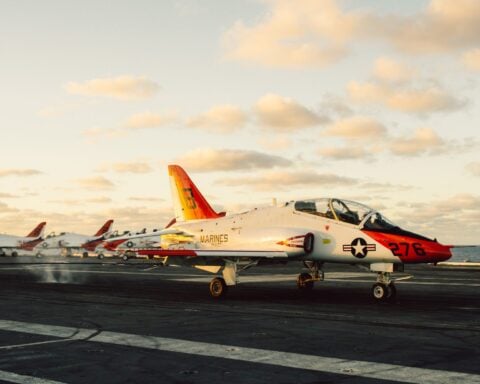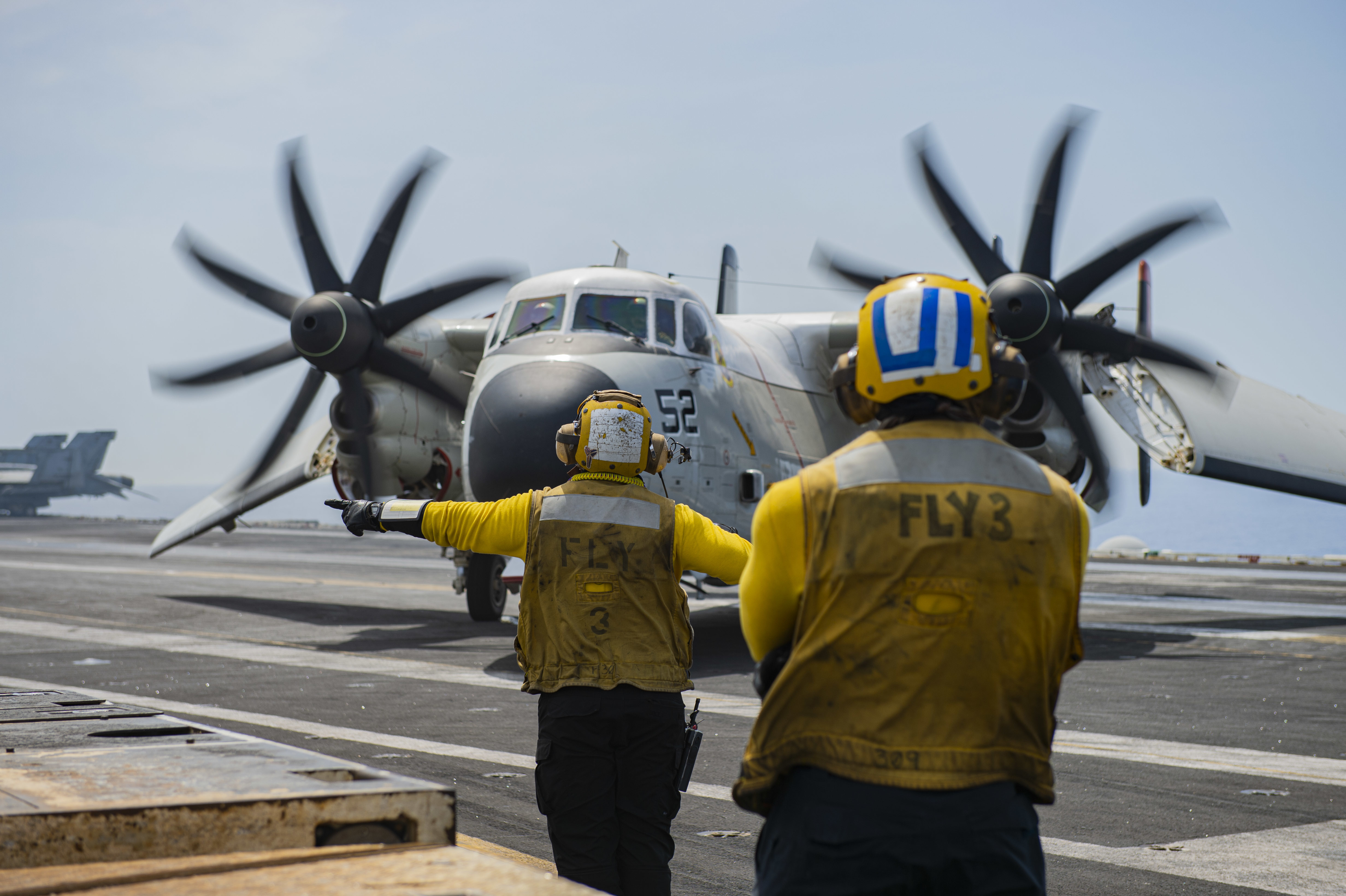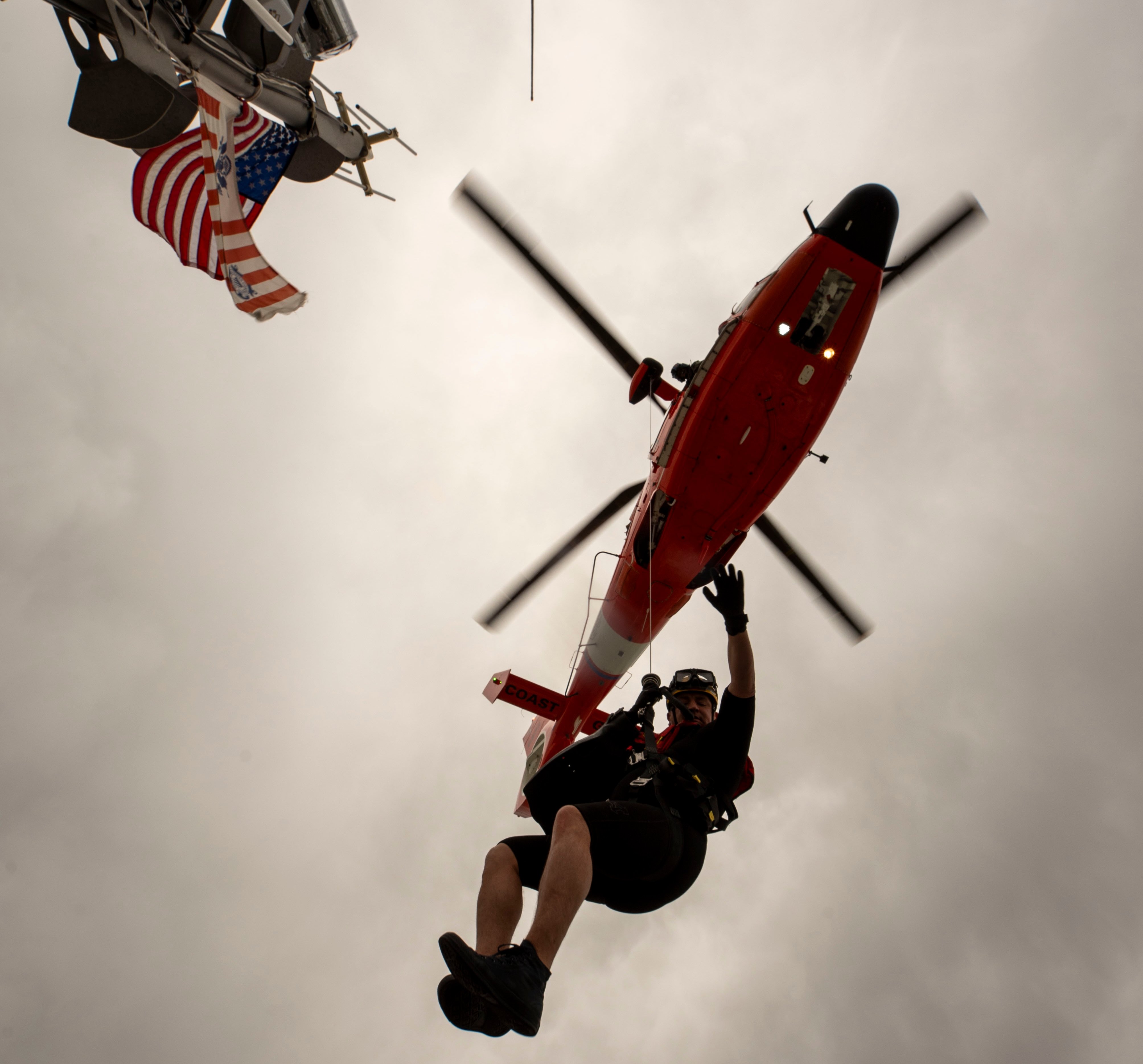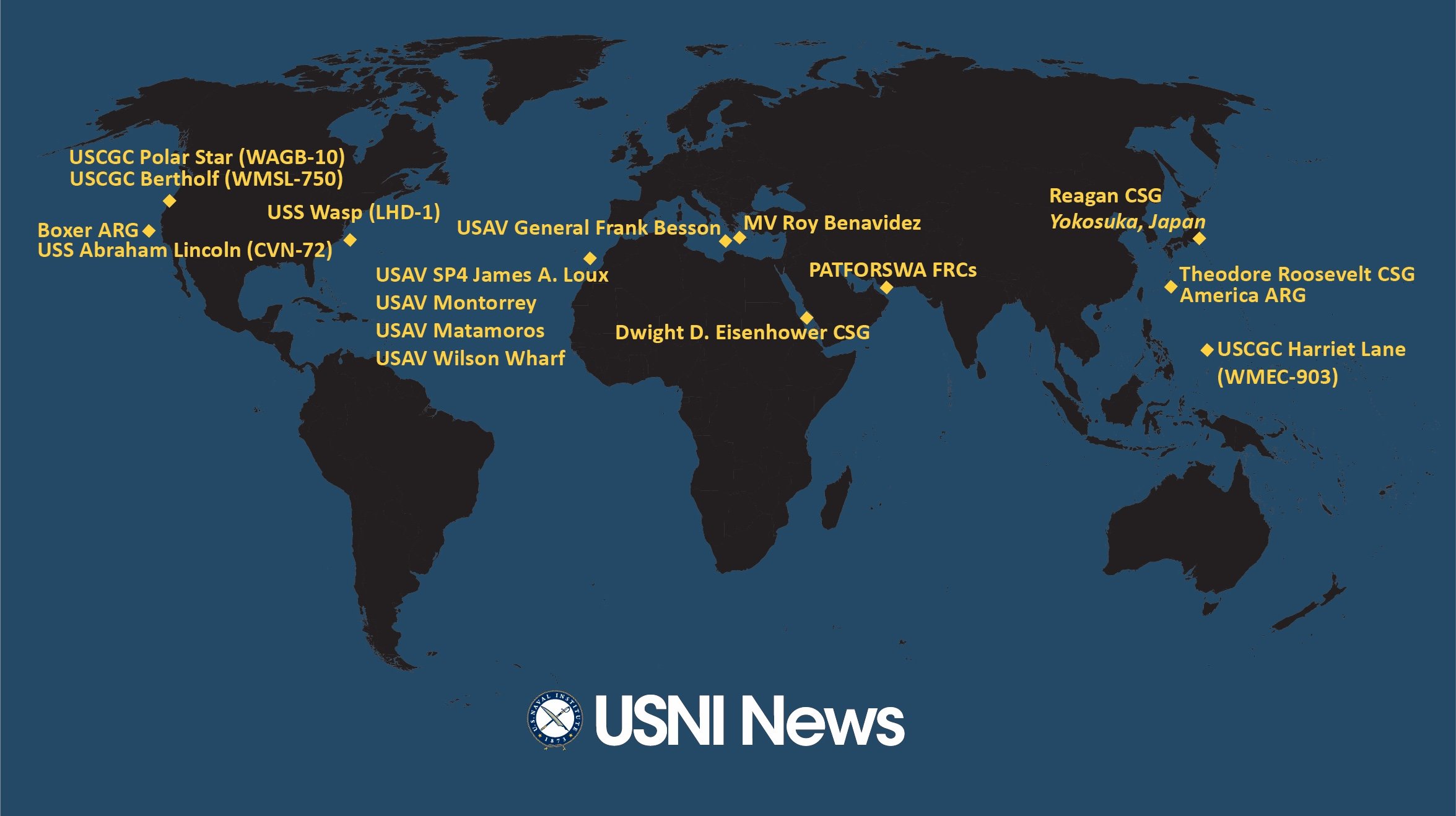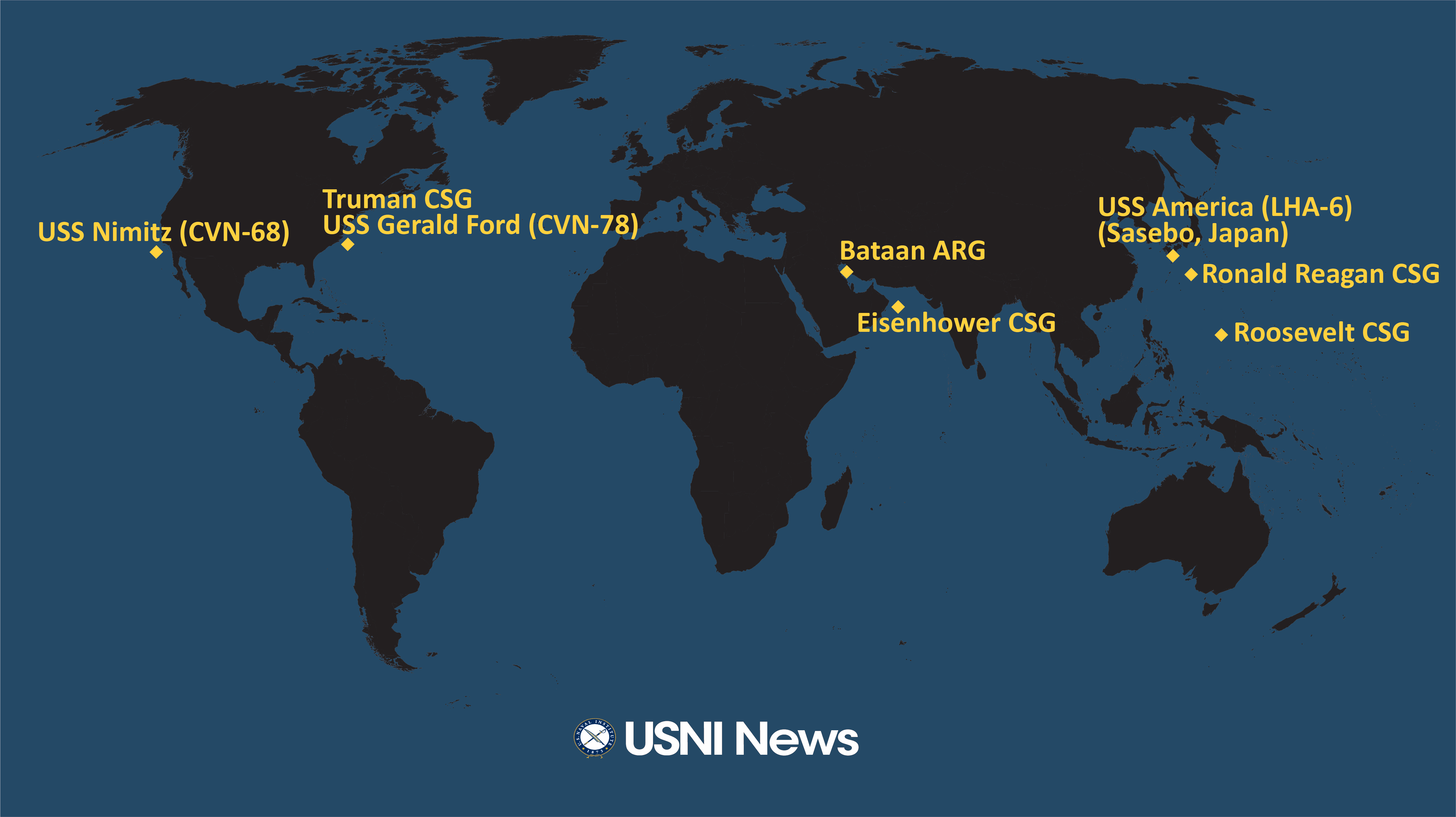
These are the approximate positions of the U.S. Navy’s deployed carrier strike groups and amphibious ready groups throughout the world as of May 25, 2020, based on Navy and public data. In cases where a CSG or ARG is conducting disaggregated operations, the chart reflects the location of the capital ship.
Total U.S. Navy Battle Force:
299
Ships Underway
| Deployed Ships Underway | Non-deployed Ships Underway | Total Ships Underway |
| 68 | 36 | 104 |
Ships Deployed by Fleet
| Fleet Forces | 3rd Fleet | 4th Fleet | 5th Fleet | 6th Fleet | 7th Fleet | Total |
| 3 | 2 | 6 | 24 | 12 | 58 | 105 |
In Japan
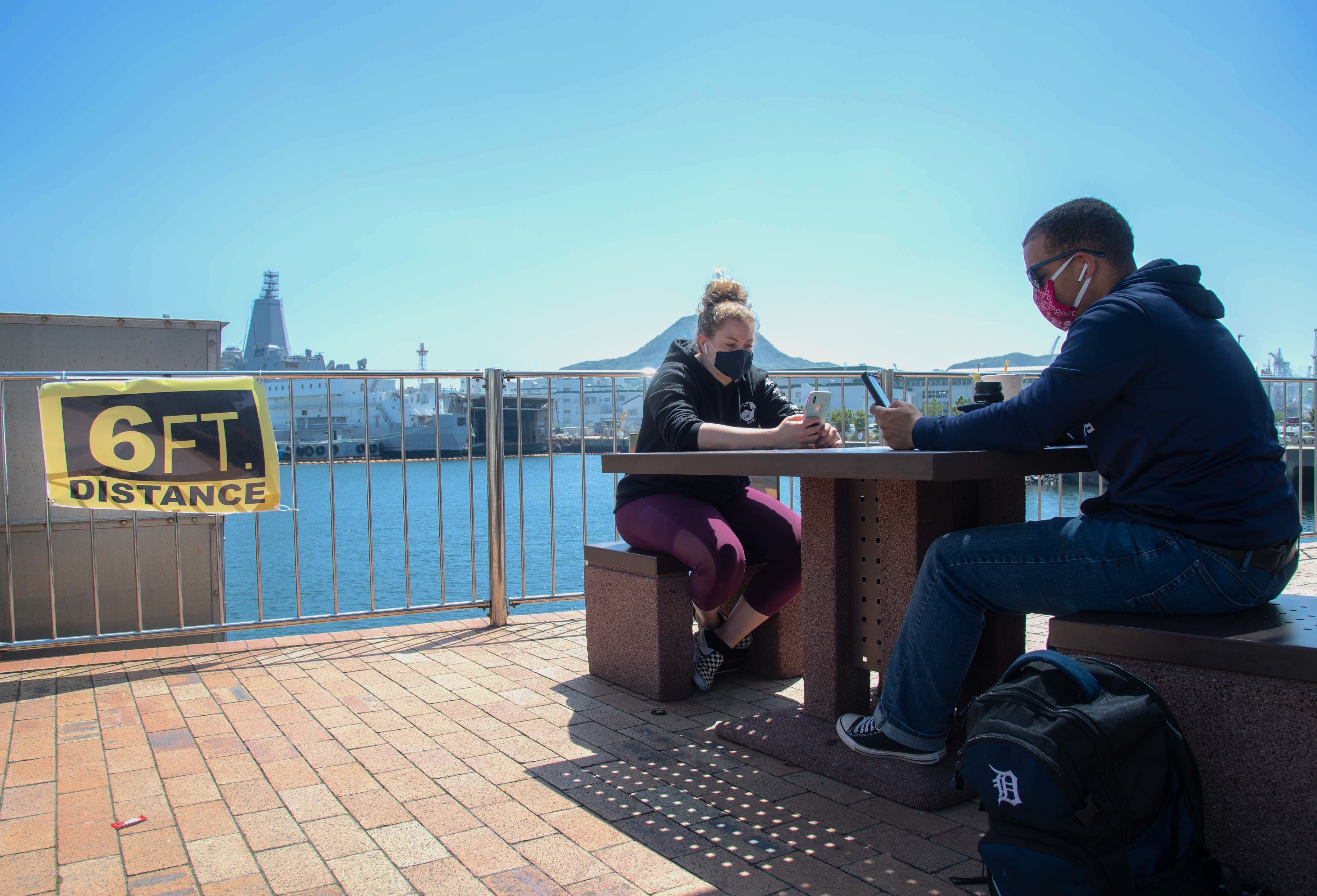
Amphibious assault ship USS America (LHA-6) is in port in Sasebo.
In the Western Pacific
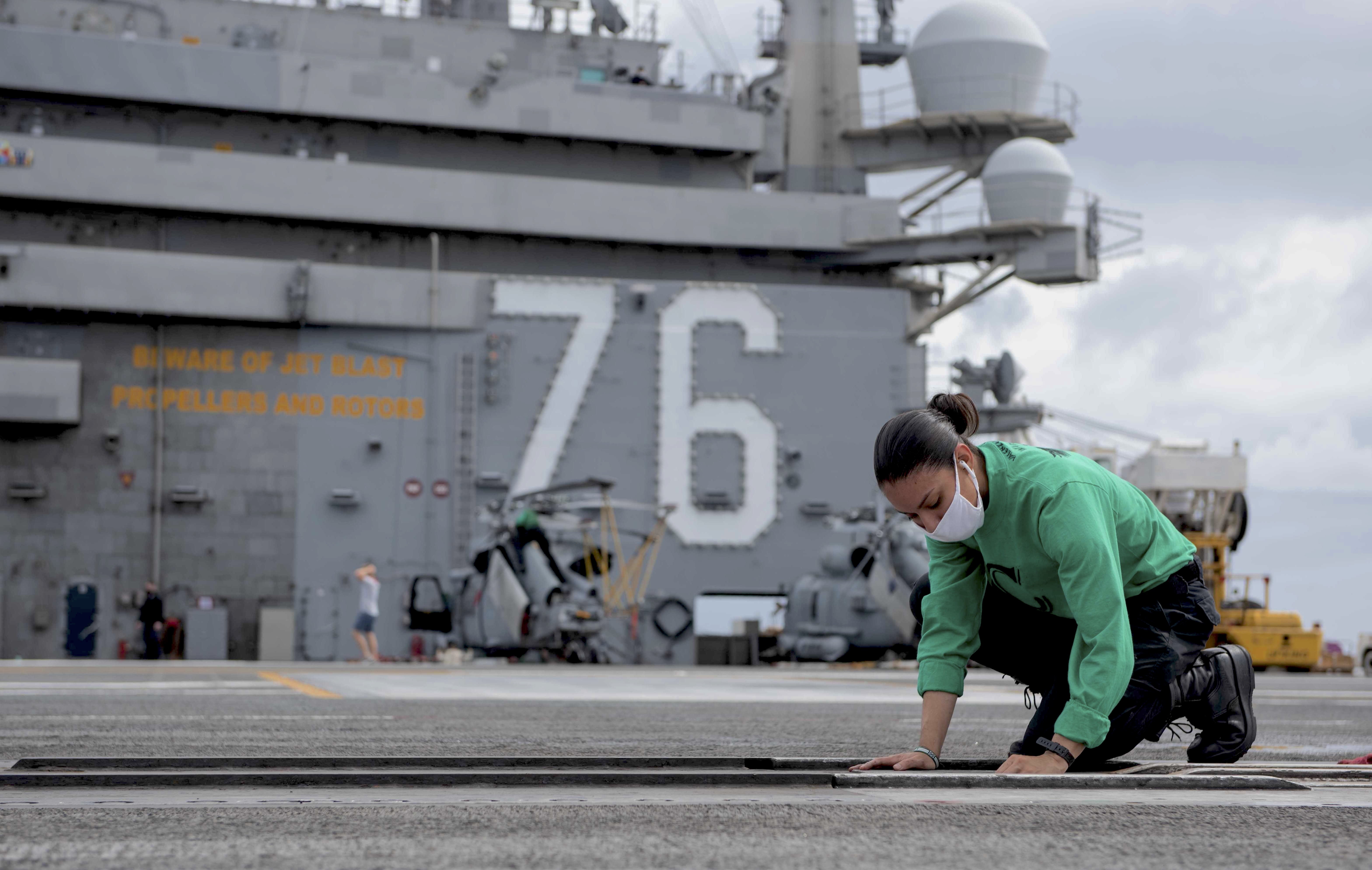
USS Ronald Reagan (CVN-76) has begun its Spring patrol having completed sea trials after its annual repair period.
Last week, USS Theodore Roosevelt (CVN-71) got underway for the first time since the carrier docked in Guam for 55 days to battle a COVID-19 outbreak that infected almost a quarter of the crew. Roosevelt left the pier at Naval Base Guam with more than half of its crew to start workups to return to full deployment readiness.
The outbreak infected more than 1,000 sailors of the 4,800 sailors aboard and resulted in the death of one crewmember.
Since the end of April, the Navy has undergone the process of moving sailors back aboard after keeping them in isolation for at least 14 days and requiring each sailor to test negative twice for COIVD-19.
“The ship will commence underway training and carrier qualifications to support the air wing’s return to operational readiness. During the underway, the ship will leave sailors ashore that are not required for these evolutions,” reads a statement from the carrier. “This will enable the ship to conduct training at sea while personnel left in Guam can support the recovery of the rest of the crew who remain in quarantine or isolation. During this transition, the ship will enforce strict cleaning protocols and maintain social distancing as part of the phased approach to returning the ship to operations.”
Carrier Strike Group 9
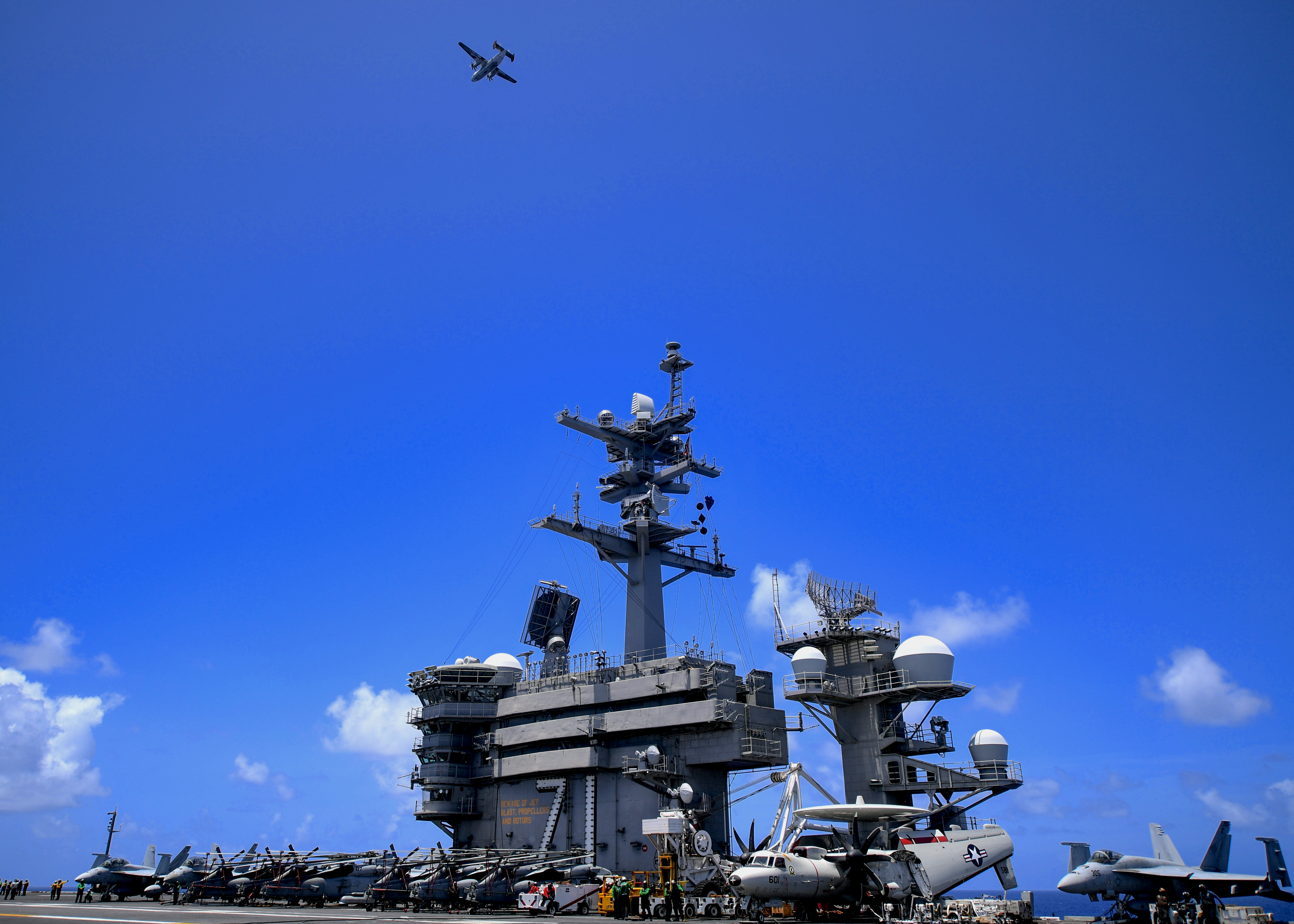
The San Diego-based CSG 9 commands the Theodore Roosevelt Carrier Strike Group and is embarked on the carrier.
Aircraft carrier
USS Theodore Roosevelt (CVN-71), homeported in San Diego, Calif.
Carrier Air Wing 11
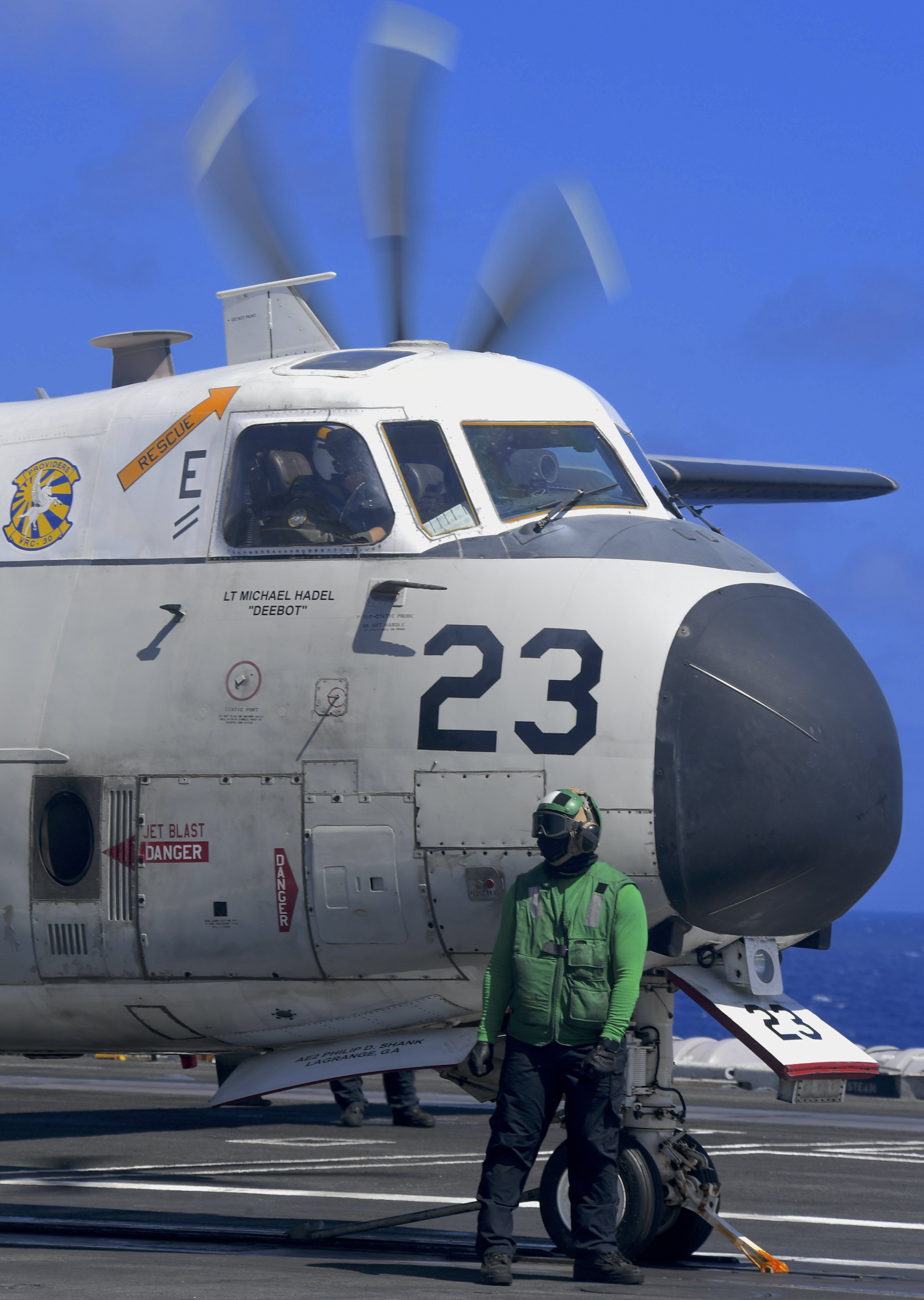
Carrier Air Wing (CVW) 11, based at Naval Air Station Lemoore, Calif., is embarked aboard Theodore Roosevelt and includes a total of nine squadrons and detachments:
- The “Tomcatters” of VFA-31 – Strike Fighter Squadron (VFA) – from Naval Air Station Oceana, Va.
- The “Golden Warriors” of VFA-87 from Naval Air Station Oceana, Va.
- The “Blue Diamonds” of VFA-146 from Naval Air Station Lemoore, Calif.
- The “Black Knights” of VFA-154 from Naval Air Station Lemoore – Calif.
- The “Gray Wolves” of VAQ-142 – Electronic Attack Squadron (VAQ) – from Naval Air Station Whidbey Island – Wash.
- The “Liberty Bells” of VAW-115 – Carrier Airborne Early Warning Squadron (VAW) – from Naval Air Station Point Mugu, Calif.
- The “Providers” of VRC-30 – Detachment – Fleet Logistics Support Squadron (VRC) – from Naval Air Station North Island, Calif.
- The “Eight Ballers” of HSC-8 – Helicopter Sea Combat Squadron (HSC) – from Naval Air Station North Island, Calif.
- The “Wolf Pack” of HSM-75 – Helicopter Maritime Strike Squadron (HSM) – from Naval Air Station North Island, Calif.
Cruiser
USS Bunker Hill (CG-52), homeported in San Diego, Calif.
Destroyer Squadron 23
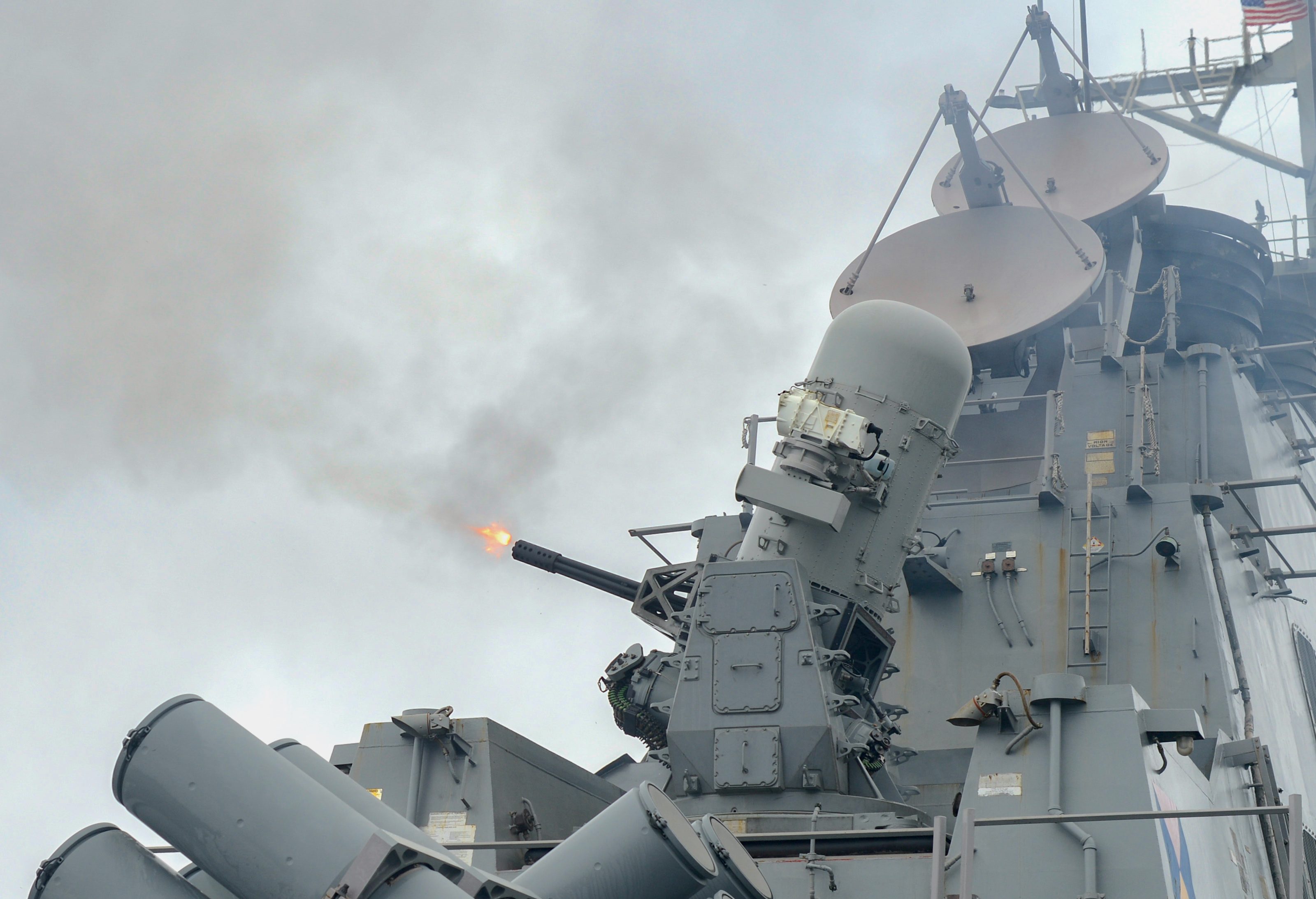
Destroyer Squadron 23 is based in San Diego and is embarked on the carrier.
Destroyers
- USS Russell (DDG-59), homeported in San Diego, Calif.
- USS Paul Hamilton (DDG-60), homeported in San Diego, Calif.
- USS Pinckney (DDG-91), homeported in San Diego, Calif.
- USS Rafael Peralta (DDG-115), homeported in San Diego, Calif.
In the Persian Gulf
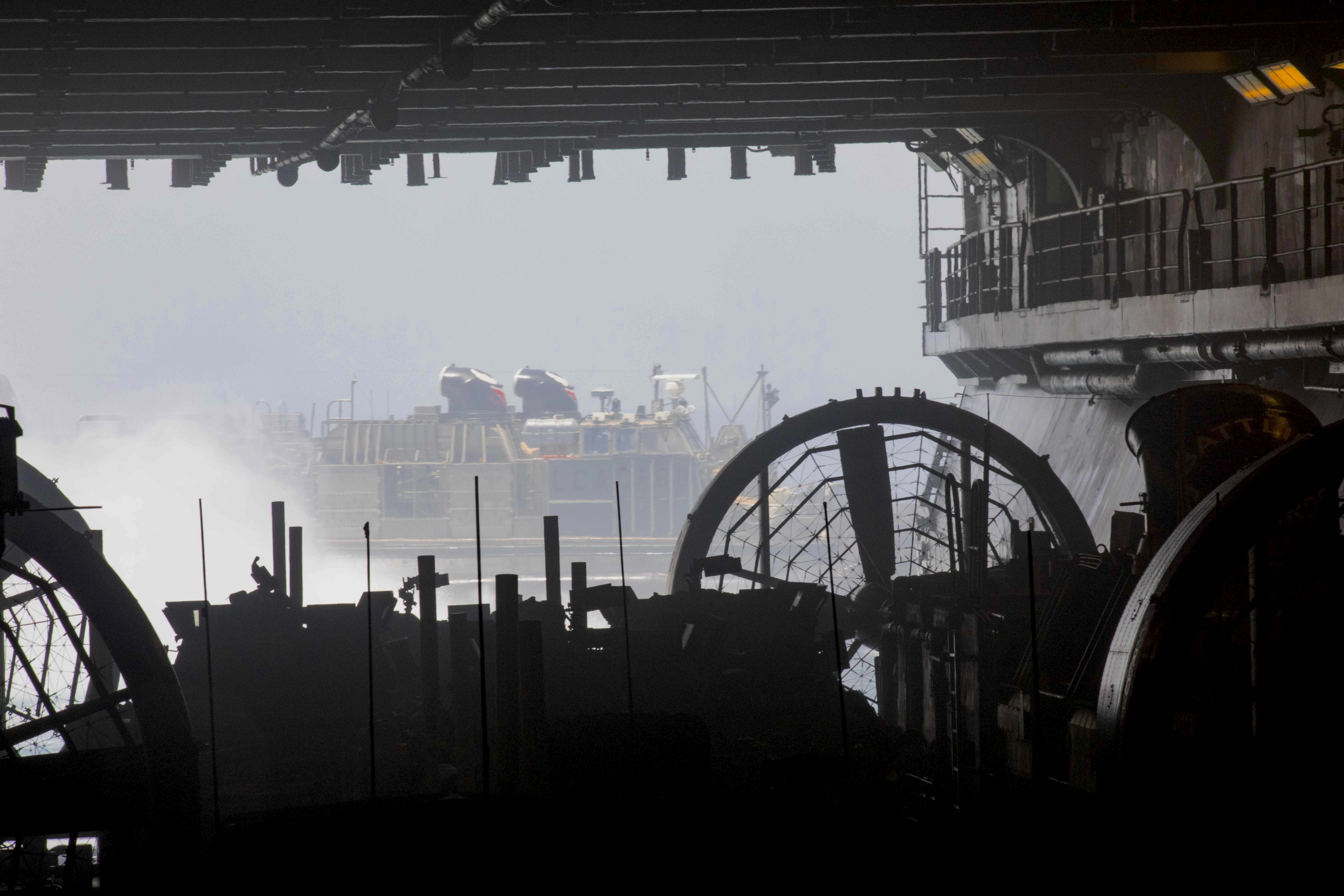
The Bataan Amphibious Ready Group (ARG) and embarked 26th Marine Expeditionary Unit (MEU) are in the Persian Gulf.
The ARG is commanded by Amphibious Squadron (PHIBRON) 8 and includes amphibious assault ship USS Bataan (LHD-5), amphibious transport dock USS New York (LPD-21) and dock landing ship USS Oak Hill (LSD-51).
The Navy alerted all international maritime traffic to maintain a safe distance of at least 100 meters from U.S. naval vessels in international waters and straits. The U.S. Navy’s stay-away warning to marine traffic in the Persian Gulf, the Arabian Sea and the Gulf of Oman was intended for Iran, Pentagon officials confirmed last week.
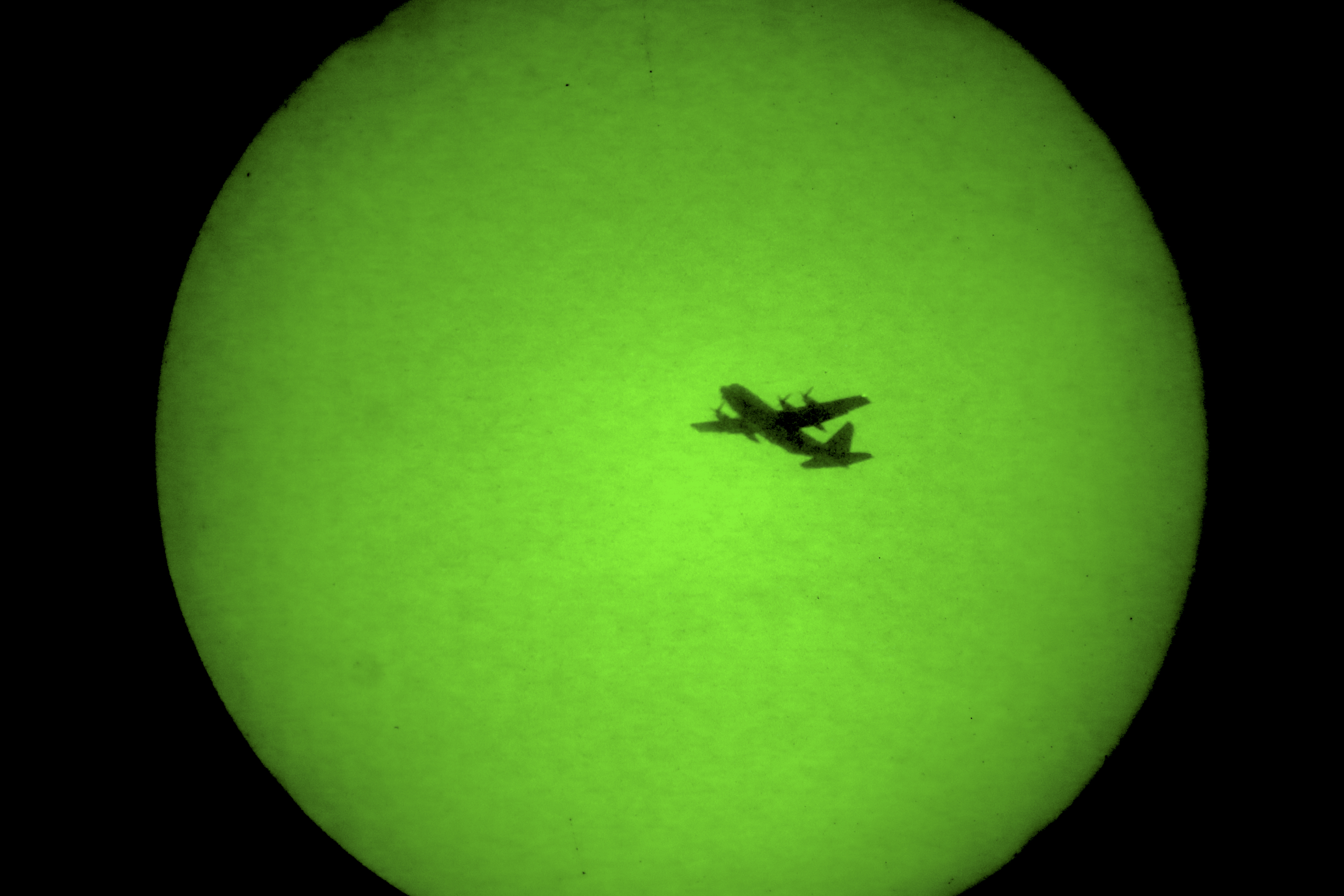
The Bataan ARG and 26th MEU conducted joint integration training with a Special Operations Command Central (SOCCENT) AC-130W Stinger II aircraft in the Persian Gulf last week. During the training, SOCCENT and 26th MEU Joint Terminal Attack Controller (JTAC) teams, stationed aboard New York and at locations ashore, directed command and control (C2) for simulated defensive strikes on surface targets from the AC-130W gunship.
In the North Arabian Sea
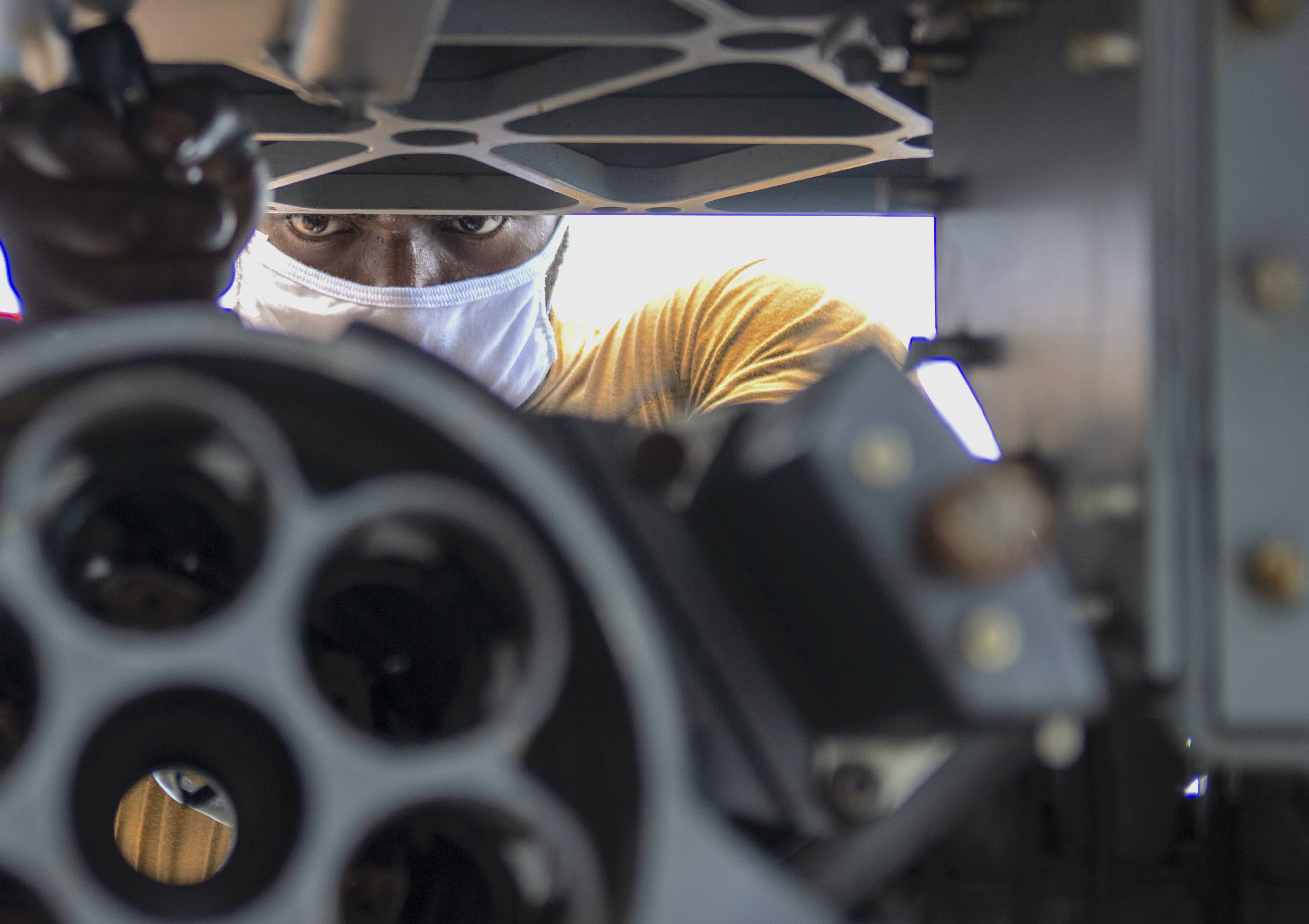
The Eisenhower Carrier Strike Group (CSG) is underway in the North Arabian Sea. USS Dwight D. Eisenhower (CVN-69) has been at sea for 100 consecutive days.
Carrier Strike Group 10

Norfolk-based CSG 10 commands the Dwight D. Eisenhower CSG and is embarked on the carrier.
Aircraft carrier
USS Dwight D. Eisenhower (CVN-69), homeported in Norfolk, Va.
Carrier Air Wing
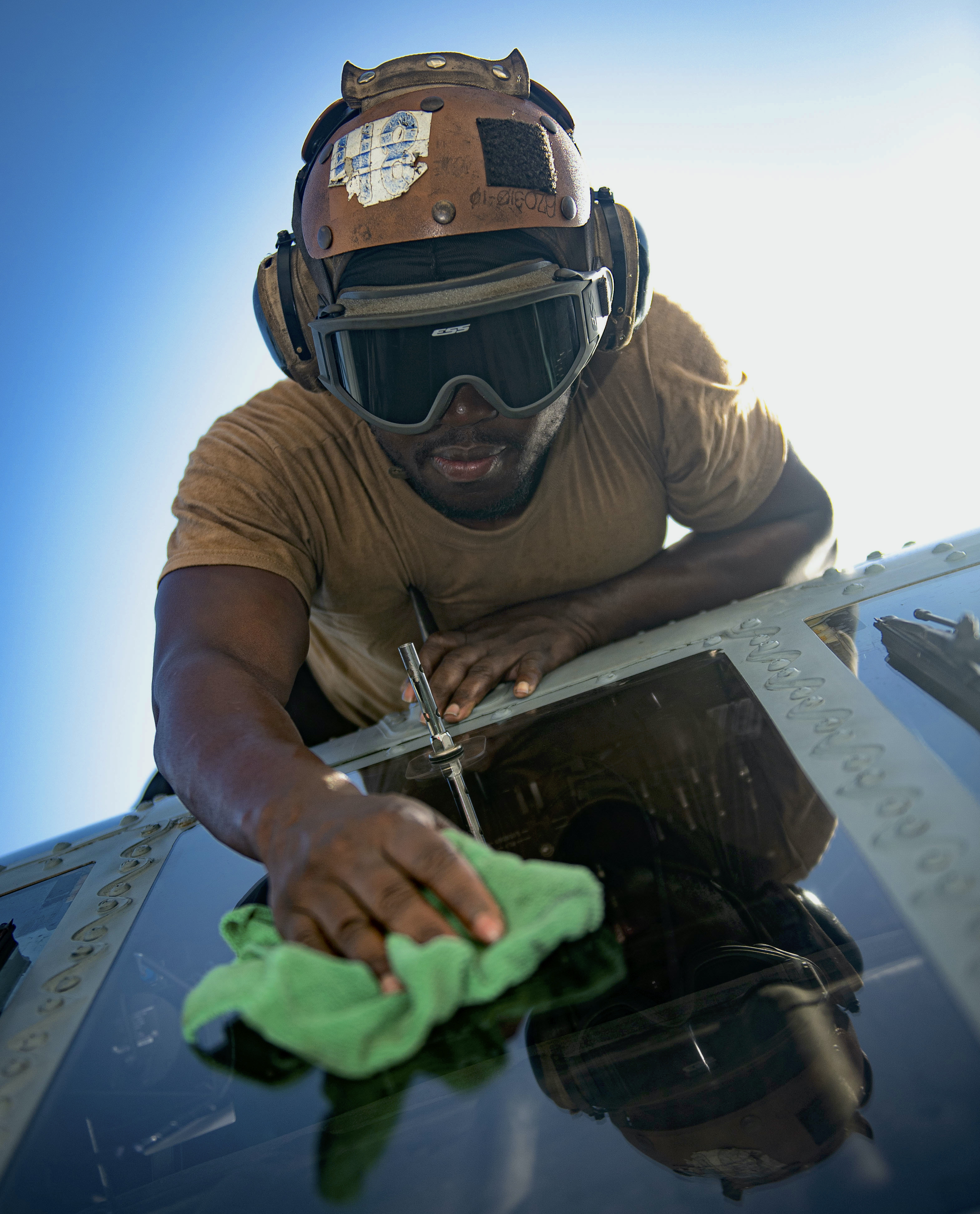
Carrier Air Wing (CVW) 3, based at Naval Air Station Oceana, Va., is embarked aboard Dwight D. Eisenhower and includes a total of nine squadrons and detachments:
- The “Gunslingers” of VFA-105 – Strike Fighter Squadron (VFA) – from Naval Air Station Oceana, Va.
- The “Wildcats” of VFA-131 from Naval Air Station Oceana, Va.
- The “Swordsmen” of VFA-32 from Naval Air Station Oceana, Va.
- The “Rampagers” of VFA-83 from Naval Air Station Oceana, Va.
- The “Zappers” of VAQ-130 – Electronic Attack Squadron (VAQ) – from Naval Air Station Whidbey Island – Wash.
- The “Screwtops” of VAW-123 – Carrier Airborne Early Warning Squadron (VAW) – from Naval Station Norfolk, Va.
- The “Rawhides” of VRC-40 – Detachment – Fleet Logistics Support Squadron (VRC) – from Naval Station Norfolk, Va.
- The “Dusty Dogs” of HSC-7 – Helicopter Sea Combat Squadron (HSC) – from Naval Station Norfolk, Va.
- The “Swamp Foxes” of HSM-74 – Helicopter Maritime Strike Squadron (HSM) – from Naval Air Station Jacksonville, Fla.
Cruiser
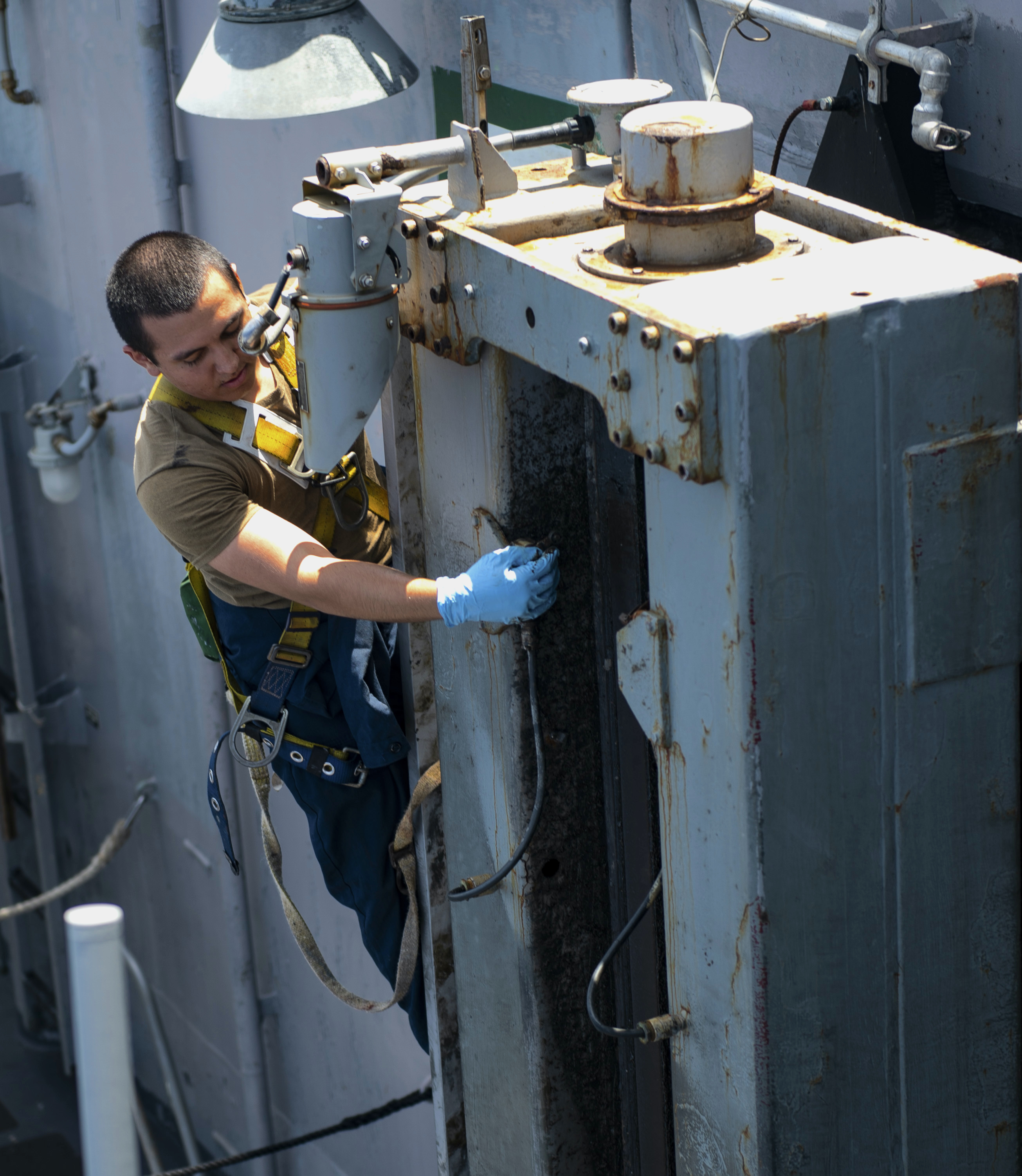
USS Vella Gulf (CG-72), homeported in Norfolk, Va.
USS San Jacinto (CG-56), homeported in Norfolk, Va.
Destroyer Squadron 26
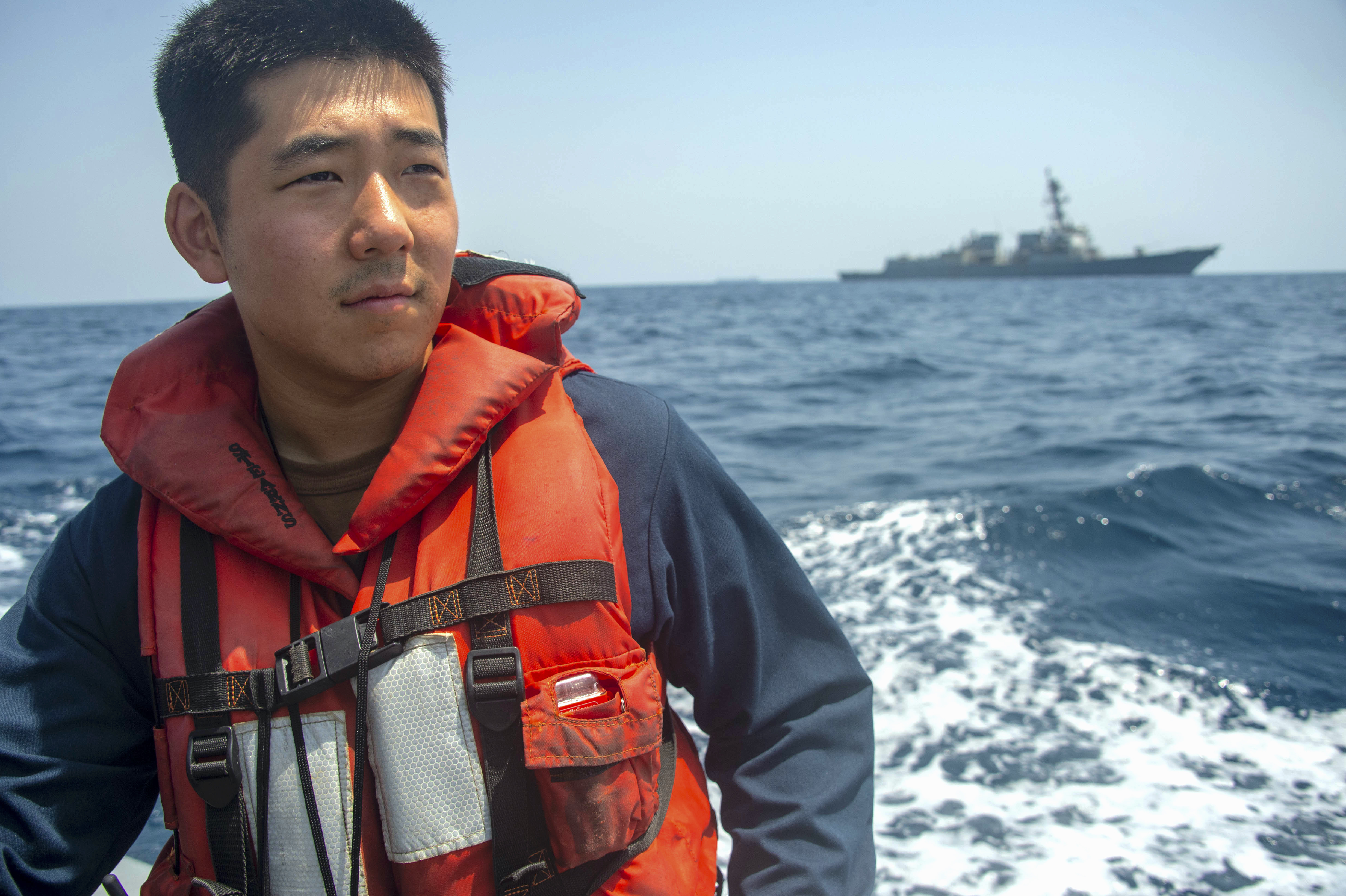
Destroyer Squadron 26 is based at Norfolk, and its leaders are embarked on Eisenhower.
- USS Stout (DDG-55), homeported in Mayport, Fla.
- USS James E. Williams (DDG-95), homeported in Mayport, Fla.
- USS Truxtun (DDG-103), homeported in Norfolk, Va.
- Royal Danish Navy frigate Iver Huitfeldt (F361)
In the Eastern Pacific

The Nimitz CSG is in the Southern California Operating Areas conducting a composite training unit exercise (COMPTUEX).
The graduation exercise for the carrier strike group will be the first major test of the Navy’s methodology to prevent COVID-19 outbreaks on its deployed ships.
The service secured enough COVID-19 test kits to evaluate the nearly 8,000 sailors of the Nimitz Carrier Strike Group. Navy officials previously told USNI News they planned test crew members before deploying. Carrier Air Wing 17, the command staff of Carrier Strike Group 11 and crews of the planned carrier escorts have been isolated in California ahead of the strike group assembling in San Diego.
While the Navy won’t discuss future operations, it’s likely the strike group will start its deployment at the conclusion of the training exercise without returning to port. Once underway, the deployment will feature few port visits and additional COVID-related restrictions.
Carrier Strike Group 11
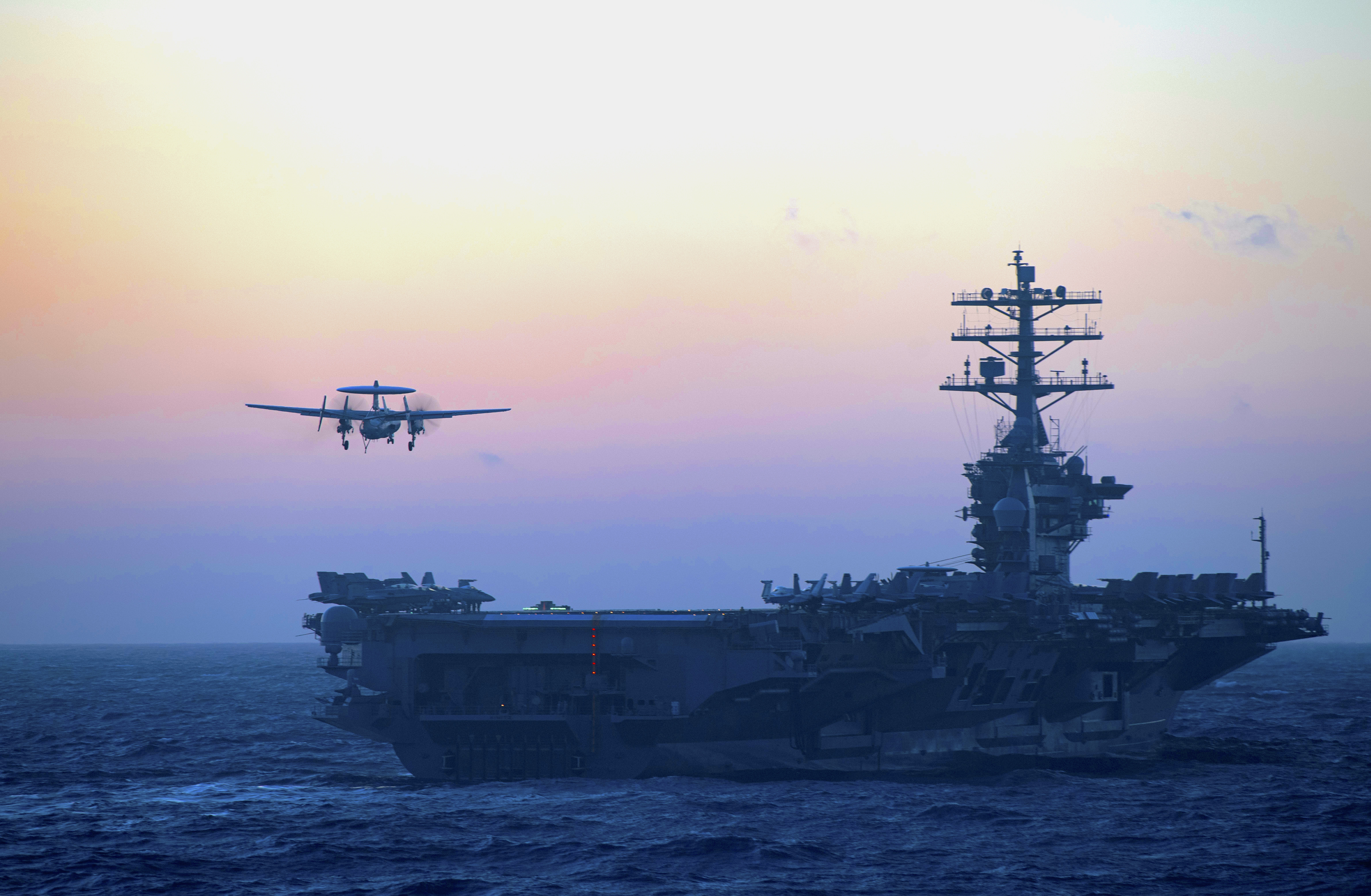
San Diego-based CSG 11 commands the Nimitz CSG and is embarked on the carrier.
Aircraft carrier
USS Nimitz (CVN-68), homeported in Bremerton, Wash.
Carrier Air Wing 17

Carrier Air Wing (CVW) 17, based at Naval Air Station Lemoore, Calif., is embarked on Nimitz and includes a total of nine squadrons and detachments:
- The “Redcocks” of VFA 22 – Strike Fighter Squadron (VFA) F/A-18F Super Hornet – from Naval Air Station Lemoore, Calif.
- The “Kestrels” of VFA137 F/A-18 E – from Naval Air Station Lemoore, Calif.
- The “Mighty Shrike” of VFA 94 F/A-18F – from Naval Air Station Lemoore, Calif.
- The “Death Rattlers” of VMFA-323 F/A-18C – from Marine Corps Air Station Miramar San Diego, Calif.
- The “Cougars” of VAQ-139 – Electronic Attack Squadron (VAQ) EA-18G Growlers – from Naval Air Station Whidbey Island – Wash.
- The “Sun Kings” of VAW-116 –Carrier Airborne Early Warning Squadron (VAW) E2C Hawkeye – from Naval Air Station Point Mugu, Calif.
- The “Providers” of VRC-30 – Detachment – Fleet Logistics Support Squadron (VRC) C-2 – from Naval Air Station North Island, Calif.
- The “Screamin’ Indians” of HSC-6 – Helicopter Sea Combat Squadron (HSC) MH-60S– from Naval Air Station North Island, Calif.
- The “Battlecats” of HSM-73 – Helicopter Maritime Strike Squadron (HSM) MH60R – from Naval Air Station North Island, Calif.
Cruiser
USS Princeton (CG-59), homeported in San Diego, Calif.
Destroyer Squadron 9
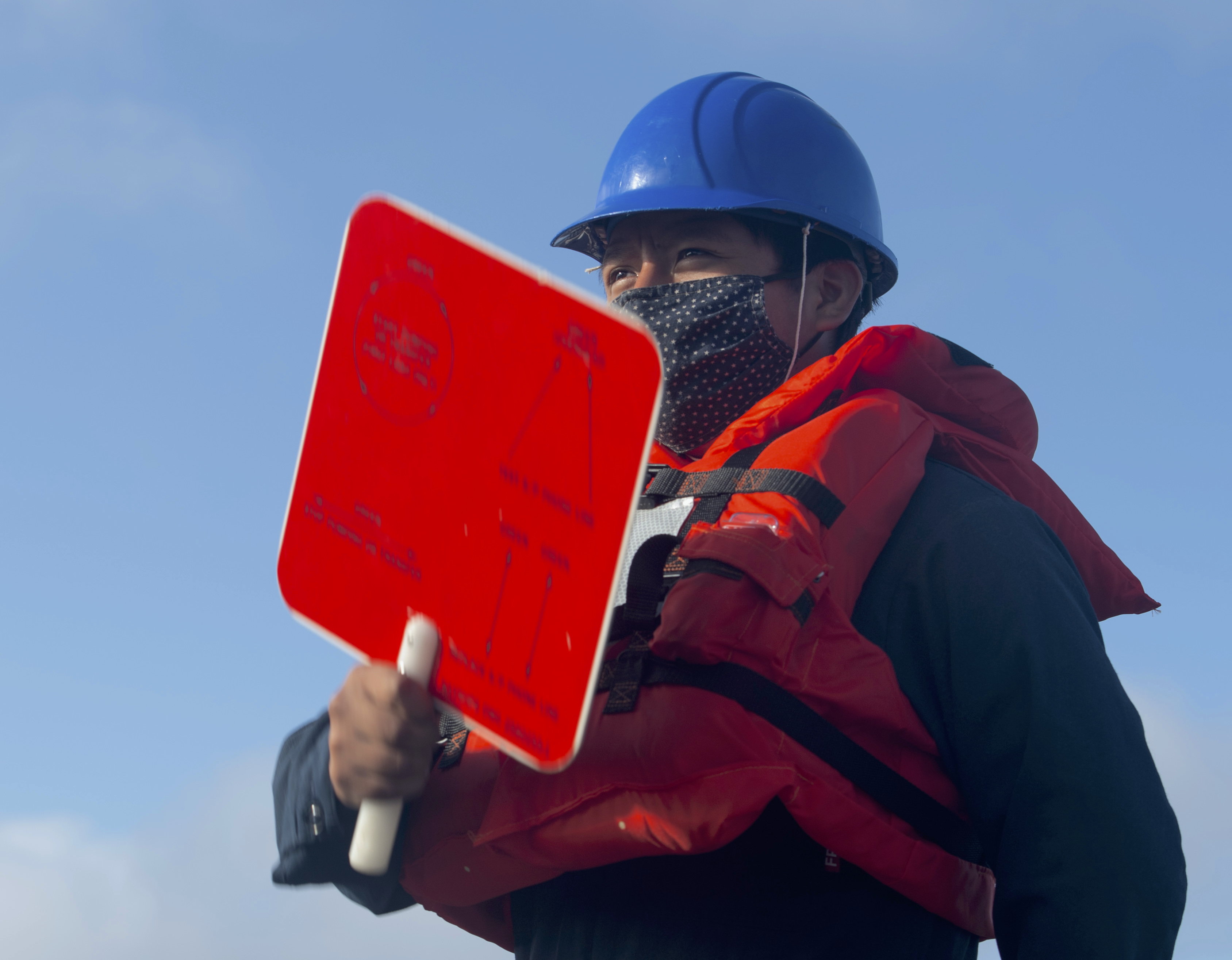
Destroyer Squadron 9 is based at Naval Station, Everett Wash. The DESRON Commodore and staff will be embarked on Nimitz.
- USS John Paul Jones (DDG-53), homeported in Pearl Harbor, Hawaii
- USS Sterett (DDG-104), homeported in San Diego, Calif.
- USS Ralph Johnson (DDG-114) homeported in Everett, Wash.
In the Western Atlantic
The Truman Strike Group wrapped up its second deployment in two years. The HSTCSG is comprised of the flagship Nimitz-class aircraft carrier USS Harry S. Truman (CVN-75) and the embarked squadrons of Carrier Air Wing (CVW) 1, Ticonderoga-class guided-missile cruiser USS Normandy (CG-60) and Arleigh Burke-class guided-missile destroyer USS Forrest Sherman (DDG-98).
The CSG conducted a week of naval air integration exercises with the 2nd Marine Aircraft Wing from May 12 to 18. Marine Corps support included F/A-18C Hornets assigned to Marine Aircraft Group (MAG) 31, based out of Marine Corps Air Station Beaufort, South Carolina, and AV-8B Harriers assigned to MAG 14, based out of MCAS Cherry Point, N.C.
The week of day and night-time integration started with close air support exercises, in which Marine ground forces coordinated with Navy strike fighter aircraft to strike a precision target. During the close air support event, ground forces used combat communication with Navy aircraft to strike the targets.
The Blue Angels completed a flyover of the U.S. Naval Academy commissioning ceremony on the morning of the 20th. On the trip back to Naval Air Station Pensacola, Florida, a formation of six F/A-18C/D Hornet aircraft performed as a salute to the Truman CSG Sailors, who remain at sea in the Atlantic as a certified carrier strike group.
Carrier Strike Group 8
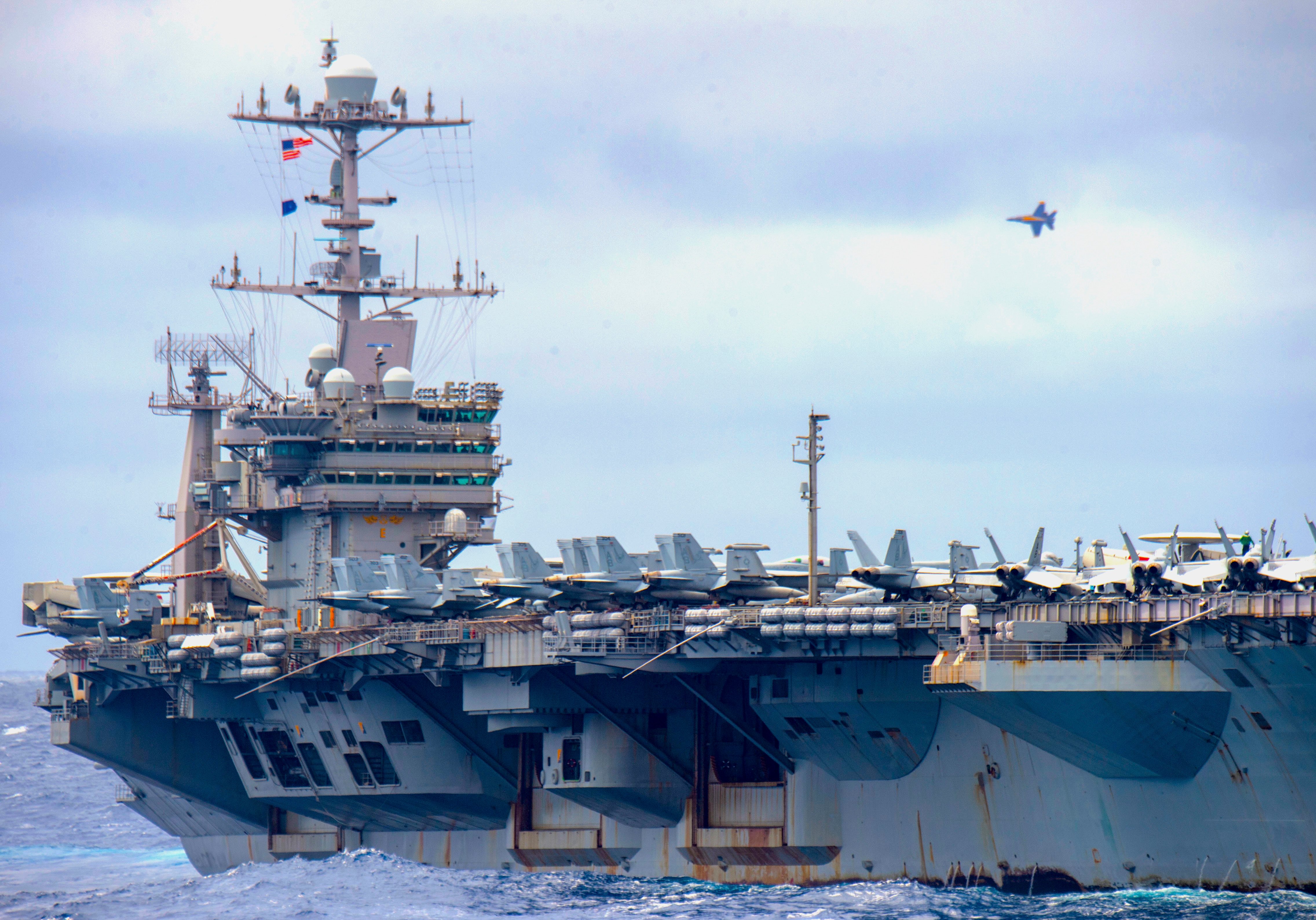
Norfolk-based CSG 8 commands the Harry S. Truman CSG and is embarked on the carrier.
Aircraft carrier
USS Harry S. Truman (CVN-75), homeported in Norfolk, Va.
Carrier Air Wing 1
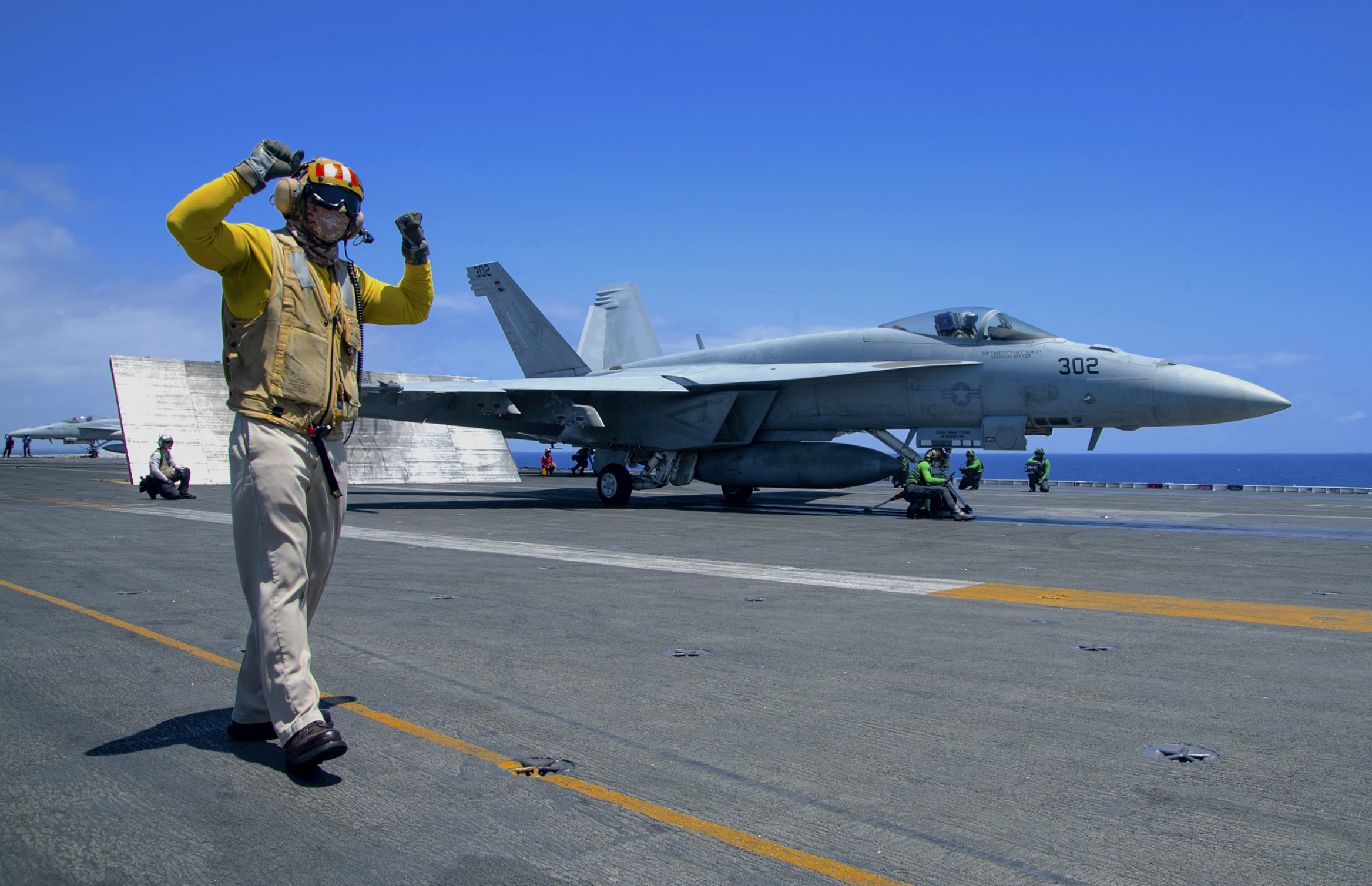
Carrier Air Wing 1 is based at Naval Air Station Oceana and is embarked on Harry S. Truman:
- The “Red Rippers” of VFA-11 – Strike Fighter Squadron (VFA) – from Naval Air Station Oceana – Va.
- The “Checkmates” of VFA-211 from Naval Air Station Oceana – Va.
- The “Sunliners” of VFA-81 from Naval Air Station Oceana – Va.
- The “Knighthawks” of VFA-136 from Naval Air Station Lemoore – Calif.
- The “Rooks” of VAQ-137 – Electronic Attack Squadron (VAQ) – from Naval Air Station Whidbey Island – Wash.
- The “Seahawks” of VAW-126 – Carrier Airborne Early Warning Squadron (VAW) – from Naval Station Norfolk – Va.
- The “Rawhides” of VRC-40 – Detachment – Fleet Logistics Support Squadron (VRC) – from Naval Station Norfolk – Va.
- The “Dragon Slayers” of HSC-11 – Helicopter Sea Combat Squadron (HSC) – from Naval Station Norfolk – Va.
- The “Proud Warriors” of HSM-72 – Helicopter Maritime Strike Squadron (HSM) – from Naval Air Station Jacksonville – Fla.
Cruiser
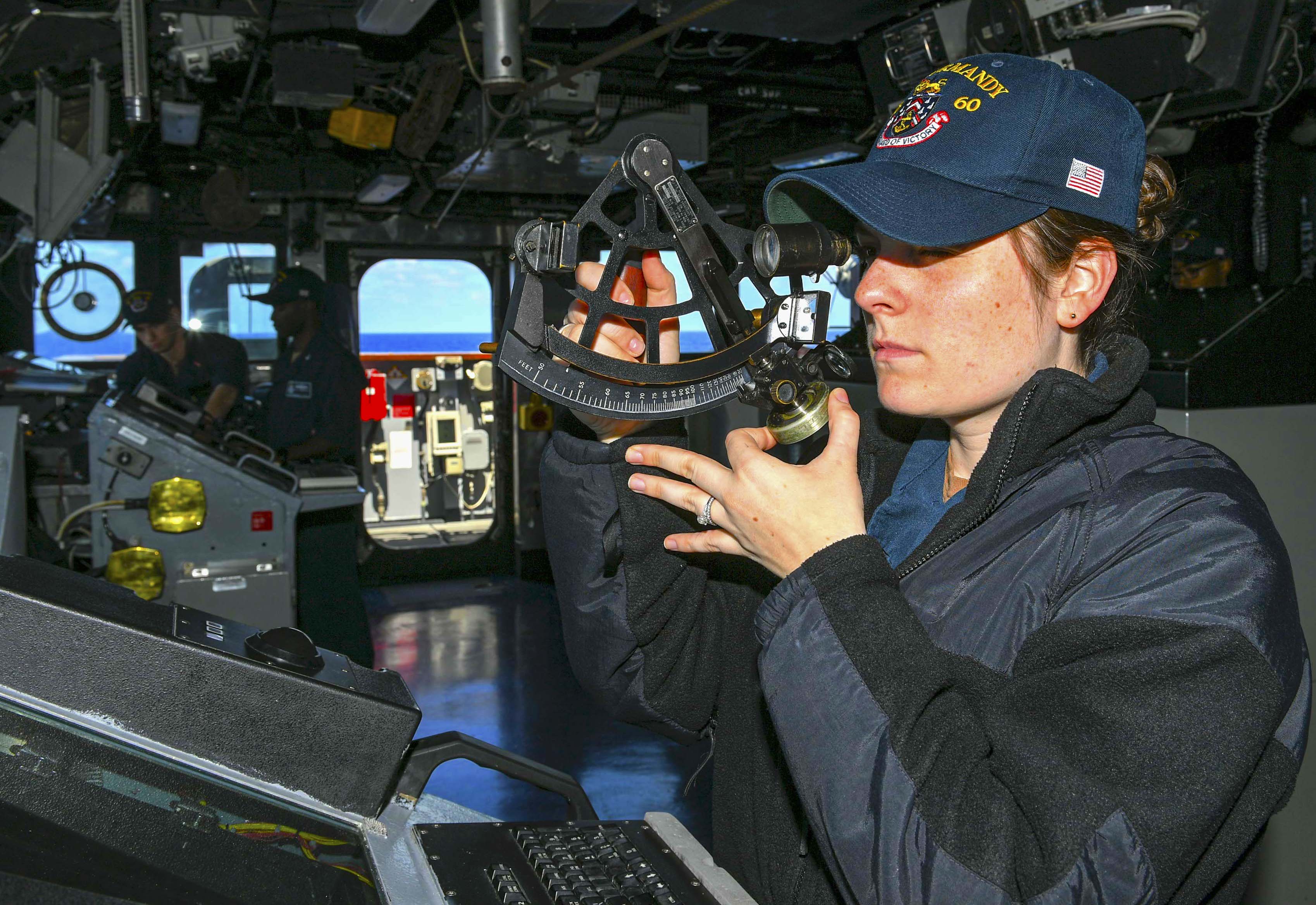
USS Normandy (CG-60), homeported in Norfolk, Va.
Destroyer Squadron 28
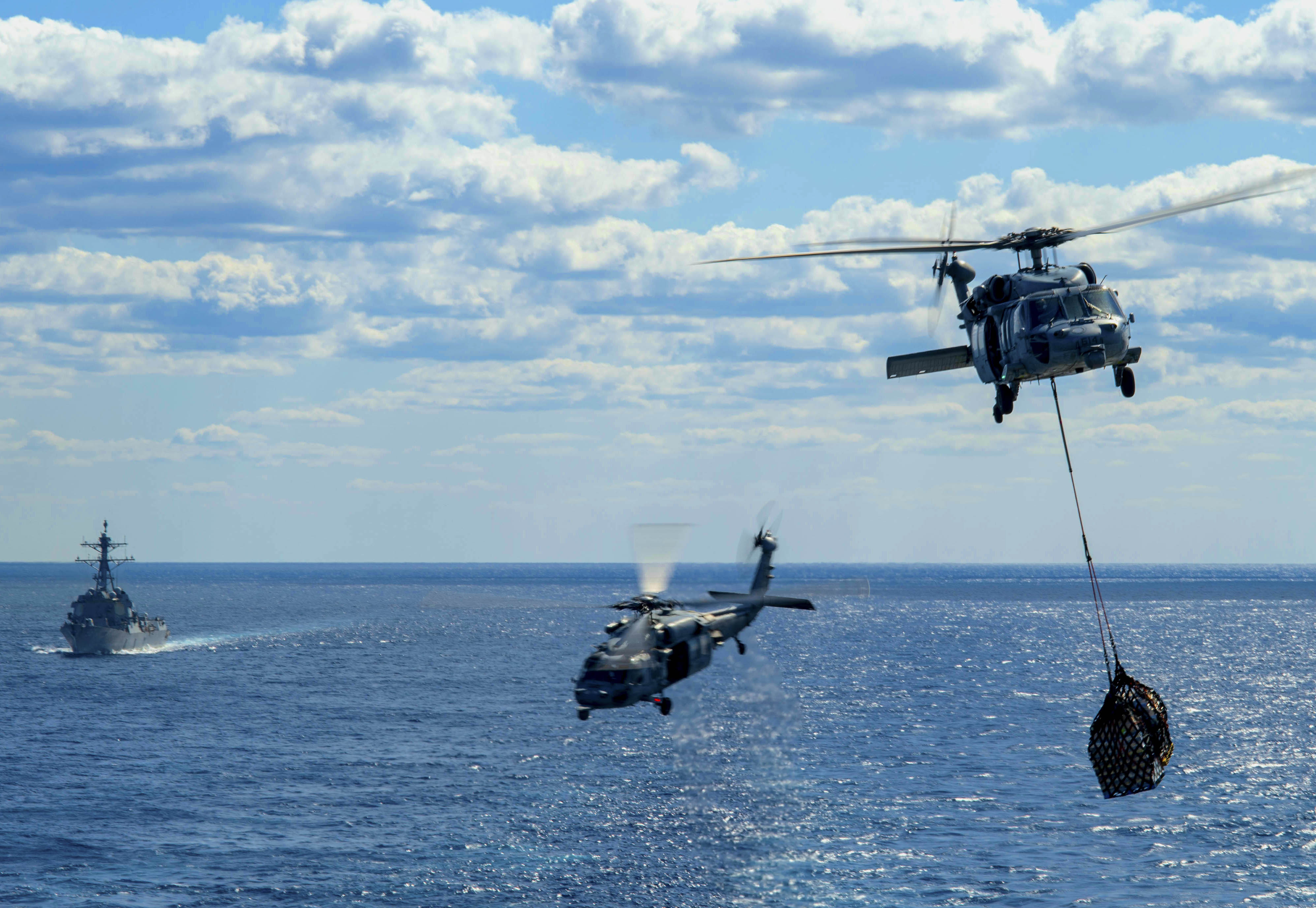
Destroyer Squadron 28 is based at Norfolk, and its leaders are embarked on Truman.
- USS Forrest Sherman (DDG-98), homeported in Norfolk, Va.
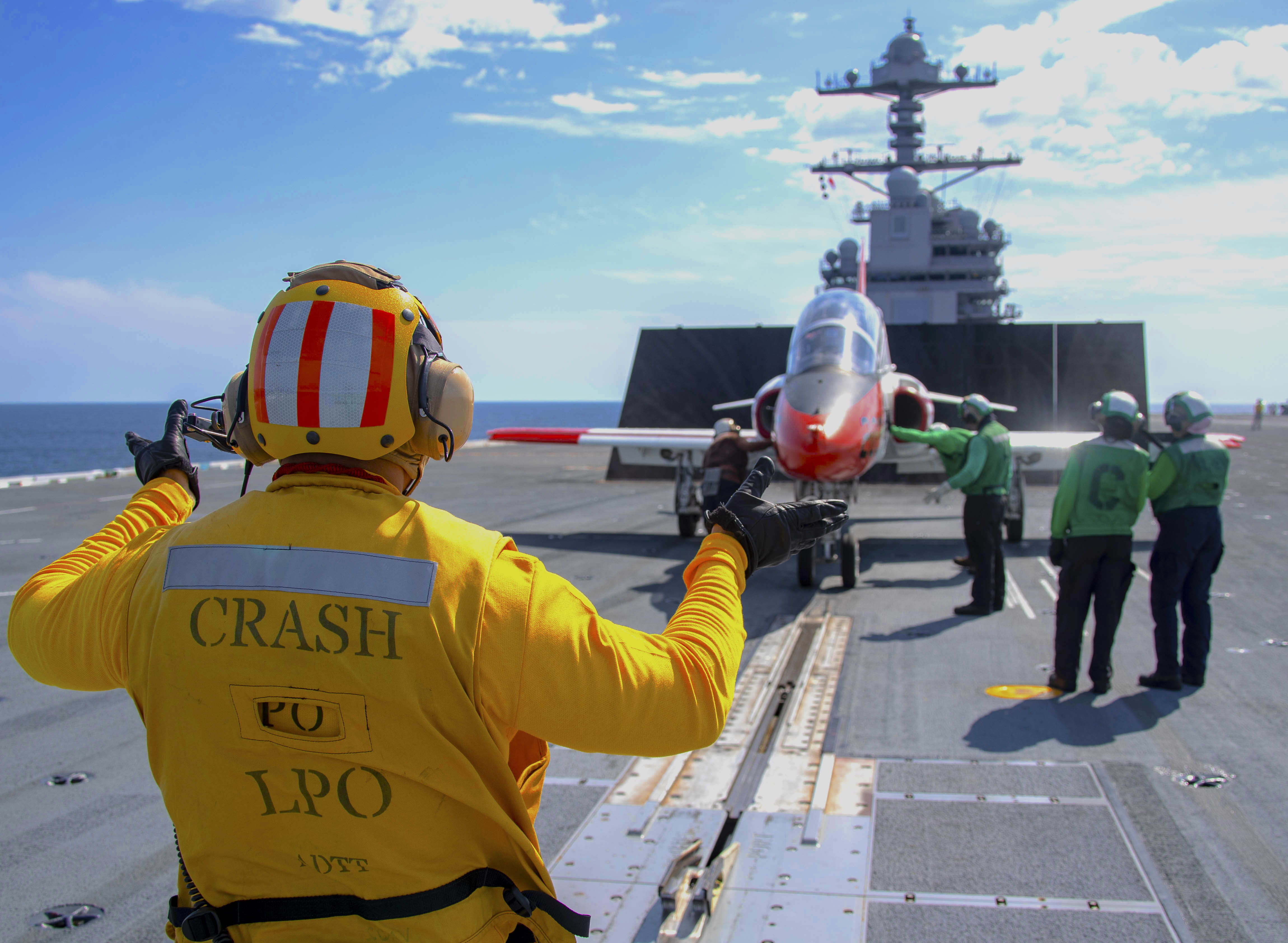
USS Gerald R. Ford (CVN-78) is underway in the Virginia Capes Operating Areas.
The carrier is getting ready to bring the air wing on for full cyclic operations. In addition to continuing to refine operations with the new Advanced Arresting Gear system and Electromagnetic Aircraft Launch System, the ship’s crew will also get to start working through the process of bringing ammunition up to the flight deck and loading it on aircraft.
Delays on the advanced weapons elevator construction meant that, until last month, the crew did not have the ability to move weapons from the lower magazines directly to the flight deck. The first lower elevator on Ford was certified last month and now connects the aft magazine to the flight deck. A second lower elevator connecting the forward magazine to the flight deck should be complete by the end of the fiscal year.
In addition to these major formations, not shown are thousands of others serving in submarines, individual surface ships, aircraft squadrons, SEALs, Special Purpose Marine Air-Ground Task Forces, Seabees, Coast Guard cutters, EOD Mobile Units, and more serving throughout the globe.


